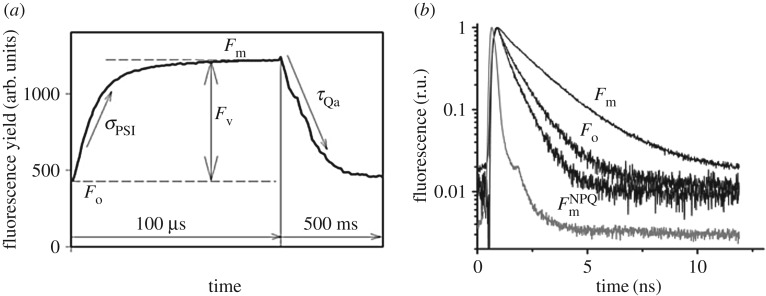Figure 1.
The concept of amplitude-based variable fluorescence (a) and picosecond lifetime (b) measurements. (a) Amplitude-based variable fluorescence techniques, such as fast repetition rate (FRR) or fluorescence induction and relaxation (FIRe), rely on recording the changes in fluorescence intensities induced by saturating flashes of excitation light on micro- and milli-second time scales [10,11]. The quantum yield of photochemistry in photosystem II (PSII) (i.e. photosynthetic efficiency) is deduced from the relative change in fluorescence yield (Fv/Fm). The effective absorption cross section of PSII (σPSII) is derived from the rate of fluorescence rise during the first 100 µs of the induction curve. The subsequent relaxation in fluorescence yield on millisecond time scale reflects the rates of photosynthetic electron transport delivered on the acceptor side of PSII. Most of those electrons are used in carbon fixation. All amplitude-based fluorometers record fluorescence yields in arbitrary units and do not measure absolute quantum yields of fluorescence. (b) Picosecond-resolved measurements of fluorescence lifetimes—fluorescence is induced by an ultra-short laser pulse (grey line) and the decay kinetics is recorded on pico- and nano-second time scales. The rate of fluorescence decay (i.e. lifetime) is directly proportional to the absolute quantum yield of fluorescence. The three profiles show fluorescence kinetics of phytoplankton at different physiological states of photosystem II reaction centres. Fo was recorded in dark-adapted cells with open reaction centres (when the quantum yield of photochemistry is maximum), Fm in dark-adapted cells with closed centres (when photochemistry is nil),  under high light exposure (1500 µmol quanta m−2 s−1) with closed centres. The reduction in the fluorescence lifetime under high light is due to non-photochemical quenching (NPQ) [12,13]. The grey trace is the instrument response function. Both variable fluorescence and lifetime instruments (namely a mini-FIRe and picosecond lifetime fluorometer (PicoLiF), respectively [12]) have extremely high sensitivity; they can accurately measure fluorescence signals in samples as low as 0.01 mg chlorophyll/m3—effectively the lowest concentration of chlorophyll recorded anywhere in the upper ocean.
under high light exposure (1500 µmol quanta m−2 s−1) with closed centres. The reduction in the fluorescence lifetime under high light is due to non-photochemical quenching (NPQ) [12,13]. The grey trace is the instrument response function. Both variable fluorescence and lifetime instruments (namely a mini-FIRe and picosecond lifetime fluorometer (PicoLiF), respectively [12]) have extremely high sensitivity; they can accurately measure fluorescence signals in samples as low as 0.01 mg chlorophyll/m3—effectively the lowest concentration of chlorophyll recorded anywhere in the upper ocean.

